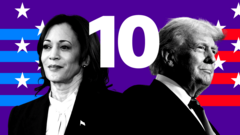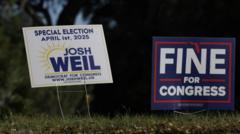**In a race both nationally and in swing states that is still too close to call, Kamala Harris and Donald Trump embody distinct but equally plausible paths to the White House.**
**Hopeful Prospects: Harris and Trump Vie for the Presidency**

**Hopeful Prospects: Harris and Trump Vie for the Presidency**
**Both candidates present compelling arguments as the 2024 election approaches, leaving voters with profound choices.**
Both candidates are riding waves of optimism as the election looms, fueled by contrasting narratives and strategies aimed at capturing the hearts and minds of voters. As polls reveal a deadlock not just nationally but within vital battleground states, this analysis delves into ten reasons why both Kamala Harris and Donald Trump can feel hopeful about their chances heading into the election.
**Trump's Potential Advantages:**
1. **Opposition to the Incumbent**
Voter dissatisfaction plays heavily into Trump's hands. With a considerable portion of the electorate feeling the pinch of inflation and a struggling economy, Trump can leverage this sentiment by asking voters whether they feel better off now than they did four years ago.
2. **Resilience Amidst Scandal**
Despite facing significant legal challenges and public criticism, Trump’s core support remains steadfast. His base interprets these attacks as politically motivated, which may galvanize his position against a backdrop of loyalty from his party.
3. **Immigration as a Key Issue**
Trump appeals to voters through his tough stance on immigration—a potent topic resonating especially since migrant encounters surged under the current administration. Polls show he holds an edge over Harris among voters regarding this critical issue.
4. **Broadening Appeal to Non-College Educated Voters**
Trump's strategy of reconnecting with working-class voters who feel overlooked has reshaped the political landscape, building new coalitions and shifting traditional allegiances.
5. **Perceived Strength and Leadership**
In times of global uncertainty, many voters perceive Trump as a decisive figure. His unorthodox approach, which some view as strength, could sway undecided voters who prioritize robust leadership.
**Harris’s Potential Advantages:**
1. **Positioning Against Trump**
Harris could capitalize on Trump’s divisive image by presenting herself as a unifying candidate. Her messaging aims to attract independents and moderate Republicans seeking stability.
2. **Separation from Biden**
Harris has quickly distanced herself from the unpopular policies of President Biden, allowing her to present a fresh vision that energizes the Democratic base.
3. **Focus on Women’s Rights**
Following the Supreme Court’s decision to overturn Roe v. Wade, Harris has become a beacon for women's rights, likely inspiring turnout from those passionate about reproductive freedom.
4. **Higher Likelihood of Voter Turnout**
Harris's coalition mainly comprises college-educated and older voters—groups that historically have higher voter turnout—giving her an advantage in mobilizing support.
5. **Financial Dominance in Campaigning**
Harris has outpaced Trump in fundraising and campaign expenditures, allowing for a more extensive advertising reach. In a neck-and-neck race, financial resources may play a critical role in swaying undecided voters.
As the election day approaches, both candidates possess unique strengths and weaknesses that increase their chances of securing a victory. Each represents not only contrasting policies but also differing visions for the future of America, setting the stage for a compelling and consequential election in 2024.
**Trump's Potential Advantages:**
1. **Opposition to the Incumbent**
Voter dissatisfaction plays heavily into Trump's hands. With a considerable portion of the electorate feeling the pinch of inflation and a struggling economy, Trump can leverage this sentiment by asking voters whether they feel better off now than they did four years ago.
2. **Resilience Amidst Scandal**
Despite facing significant legal challenges and public criticism, Trump’s core support remains steadfast. His base interprets these attacks as politically motivated, which may galvanize his position against a backdrop of loyalty from his party.
3. **Immigration as a Key Issue**
Trump appeals to voters through his tough stance on immigration—a potent topic resonating especially since migrant encounters surged under the current administration. Polls show he holds an edge over Harris among voters regarding this critical issue.
4. **Broadening Appeal to Non-College Educated Voters**
Trump's strategy of reconnecting with working-class voters who feel overlooked has reshaped the political landscape, building new coalitions and shifting traditional allegiances.
5. **Perceived Strength and Leadership**
In times of global uncertainty, many voters perceive Trump as a decisive figure. His unorthodox approach, which some view as strength, could sway undecided voters who prioritize robust leadership.
**Harris’s Potential Advantages:**
1. **Positioning Against Trump**
Harris could capitalize on Trump’s divisive image by presenting herself as a unifying candidate. Her messaging aims to attract independents and moderate Republicans seeking stability.
2. **Separation from Biden**
Harris has quickly distanced herself from the unpopular policies of President Biden, allowing her to present a fresh vision that energizes the Democratic base.
3. **Focus on Women’s Rights**
Following the Supreme Court’s decision to overturn Roe v. Wade, Harris has become a beacon for women's rights, likely inspiring turnout from those passionate about reproductive freedom.
4. **Higher Likelihood of Voter Turnout**
Harris's coalition mainly comprises college-educated and older voters—groups that historically have higher voter turnout—giving her an advantage in mobilizing support.
5. **Financial Dominance in Campaigning**
Harris has outpaced Trump in fundraising and campaign expenditures, allowing for a more extensive advertising reach. In a neck-and-neck race, financial resources may play a critical role in swaying undecided voters.
As the election day approaches, both candidates possess unique strengths and weaknesses that increase their chances of securing a victory. Each represents not only contrasting policies but also differing visions for the future of America, setting the stage for a compelling and consequential election in 2024.






















